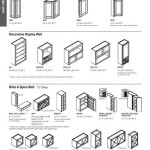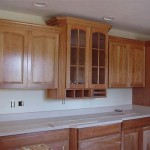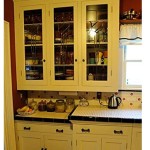Cleaning Grease Off Kitchen Cabinet Doors: A Comprehensive Guide
Kitchen cabinet doors, particularly those near the stovetop, are magnets for grease and grime. Cooking splatters, airborne oils, and everyday dust combine to form a stubborn, sticky coating that can be challenging to remove. Neglecting this build-up not only makes the kitchen look unkempt but can also damage the cabinet finish over time. This article provides a detailed guide for effectively cleaning grease off kitchen cabinet doors, covering various methods and preventative measures.
The accumulation of grease on kitchen cabinets is a gradual process. As cooking occurs, tiny droplets of oil and fat become airborne. These droplets then settle on nearby surfaces, including cabinet doors. Over time, these deposits attract dust and other particles, creating a thick, sticky layer that is difficult to remove with simple wiping. Different types of cooking oils and fats contribute to the problem, with some being more prone to solidifying and adhering to surfaces. Furthermore, the humidity levels in the kitchen, particularly during cooking, can exacerbate the problem by creating a more conducive environment for grease to accumulate.
Understanding the nature of grease is crucial for selecting the appropriate cleaning method. Grease is hydrophobic, meaning it repels water. Therefore, water alone is ineffective in removing it. Successful cleaning requires a solvent or emulsifier that can break down the grease and allow it to be wiped away. The choice of cleaning agent depends on the type of cabinet finish and the severity of the grease build-up. Harsh chemicals can damage delicate finishes, while milder solutions may not be effective on heavily soiled surfaces. Careful consideration of these factors is essential for achieving optimal results without causing damage.
Choosing the Right Cleaning Supplies and Tools
The effectiveness of any cleaning method depends heavily on the tools and supplies used. Selecting the right materials can save time and effort while minimizing the risk of damage to the cabinet doors. A soft cloth, preferably microfiber, is essential for wiping the surfaces. Microfiber cloths are absorbent and non-abrasive, making them ideal for removing grease without scratching the finish. Sponges can also be used, but it's important to use a non-abrasive sponge to prevent damage. A soft-bristled brush can be helpful for scrubbing stubborn grease build-up, especially in crevices and corners. Avoid using abrasive scrubbers or steel wool, as these can scratch the cabinet finish.
In addition to cloths, sponges, and brushes, several other tools can be helpful. A spray bottle is useful for applying cleaning solutions evenly. A small scraper, such as a plastic putty knife, can be used to gently remove thick layers of grease without damaging the surface. A steam cleaner can be a powerful tool for loosening grease, but it's important to use it carefully to avoid damaging the cabinet finish. Always test the steam cleaner on an inconspicuous area first to ensure it doesn't cause any discoloration or warping.
When it comes to cleaning solutions, there are several options to choose from, ranging from household ingredients to commercially available cleaners. Dish soap is a common and effective option for removing grease. Vinegar is another popular choice, as its acidity helps to break down grease. Baking soda can be used as a mild abrasive to scrub away stubborn build-up. Commercially available degreasers are specifically formulated to remove grease and can be effective on heavily soiled surfaces. However, it's important to choose a degreaser that is safe for the type of cabinet finish. Always read the label carefully and test the product on an inconspicuous area before applying it to the entire surface.
Effective Cleaning Methods for Grease Removal
There are several effective methods for cleaning grease off kitchen cabinet doors, each with its own advantages and disadvantages. The choice of method depends on the severity of the grease build-up and the type of cabinet finish. It's always best to start with the mildest method and gradually increase the intensity as needed.
One simple and effective method involves using warm water and dish soap. Mix a few drops of dish soap into a bowl of warm water. Dip a soft cloth into the solution and wring it out until it's damp. Wipe the cabinet doors with the damp cloth, focusing on areas with grease build-up. Rinse the cloth frequently and wring it out to avoid spreading the grease around. Once the grease has been removed, wipe the cabinet doors with a clean, damp cloth to remove any soap residue. Finally, dry the cabinet doors with a clean, dry cloth.
For more stubborn grease build-up, a solution of vinegar and water can be used. Mix equal parts white vinegar and water in a spray bottle. Spray the solution onto the cabinet doors and let it sit for a few minutes to allow the vinegar to break down the grease. Wipe the cabinet doors with a soft cloth, using gentle pressure to remove the grease. Rinse the cabinet doors with a clean, damp cloth to remove any vinegar residue. Dry the cabinet doors with a clean, dry cloth. Note: It is advisable to test the solution on an unseen area first, as vinegar can sometimes affect certain finishes.
Baking soda can be used as a mild abrasive to scrub away stubborn grease. Make a paste of baking soda and water. Apply the paste to the greasy areas and let it sit for a few minutes. Gently scrub the area with a soft-bristled brush or a non-abrasive sponge. Rinse the area with a clean, damp cloth to remove the baking soda residue. Dry the area with a clean, dry cloth. Baking soda is particularly effective for removing grease from crevices and corners.
Commercially available degreasers are formulated to remove grease effectively. However, it's essential to choose a degreaser that is safe for the type of cabinet finish. Always read the label carefully and follow the manufacturer's instructions. Test the degreaser on an inconspicuous area before applying it to the entire surface. Apply the degreaser to the cabinet doors and let it sit for the recommended amount of time. Wipe the cabinet doors with a soft cloth to remove the grease. Rinse the cabinet doors with a clean, damp cloth to remove any degreaser residue. Dry the cabinet doors with a clean, dry cloth.
For heavily soiled cabinets, a combination of methods may be necessary. Start with a mild solution of warm water and dish soap. If the grease persists, try a solution of vinegar and water. If that's not enough, use baking soda as a mild abrasive. As a final resort, use a commercially available degreaser. Always test each solution on an inconspicuous area first to ensure it doesn't damage the finish.
Preventative Measures to Minimize Grease Build-Up
Preventing grease build-up is often easier than removing it. Implementing a few simple preventative measures can significantly reduce the amount of grease that accumulates on kitchen cabinet doors. Regular cleaning is the most effective way to prevent grease build-up. Wiping down the cabinet doors with a damp cloth after each cooking session can prevent grease from accumulating and hardening. Focus on areas near the stovetop, as these are the most likely to be affected by cooking splatters.
Using a range hood or exhaust fan while cooking can help to remove airborne grease and prevent it from settling on surfaces. Ensure that the range hood or exhaust fan is properly ventilated and that the filters are cleaned regularly. Dirty filters can reduce the effectiveness of the ventilation system and allow more grease to escape into the kitchen.
Consider using splatter screens or lids while frying or cooking with oil. These screens and lids can help to contain splatters and prevent grease from landing on nearby surfaces. They are particularly useful when cooking with high heat or when using a lot of oil. Clean the splatter screens or lids regularly to prevent grease from building up on them.
Regularly cleaning the kitchen can also help to reduce grease build-up. Dusting and wiping down surfaces can prevent dust and other particles from combining with grease to form a sticky layer. Pay particular attention to areas near the stovetop, as these are the most likely to accumulate grease. Cleaning spills immediately can also prevent them from hardening and becoming difficult to remove.
Choosing the right type of cooking oil can also make a difference. Some oils are more prone to splattering and smoking than others. Oils with a high smoke point are less likely to splatter and smoke, reducing the amount of grease that becomes airborne. Consider using oils such as avocado oil, canola oil, or sunflower oil for cooking at high temperatures.
By implementing these preventative measures, it's possible to significantly reduce the amount of grease that accumulates on kitchen cabinet doors. This will not only make the kitchen look cleaner but also make it easier to clean the cabinets when necessary. Regular cleaning and preventative measures are essential for maintaining the appearance and longevity of kitchen cabinets.

How To Clean Sticky Grease Off Kitchen Cabinets Ovenclean

How To Remove Grease From Kitchen Cabinets 3 Methods Bob Vila

Get Grease Off Kitchen Cabinets Easy And Naturally

How To Clean Kitchen Cabinets Everyday Skate

How To Clean Grimy Kitchen Cabinets With 2 Ingredients

Best Ways To Clean Grease Stains Off Kitchen Cabinets

How To Clean Kitchen Cabinets In A Few Easy Steps Hunker 2024 Cleaners Homemade House Cleaning Tips

How To Clean Kitchen Cabinet Doors

How To Clean Sticky Grease Off Kitchen Cabinets

How To Clean White Kitchen Cabinets 3 Best Ways Avoid Abbotts At Home
Related Posts








